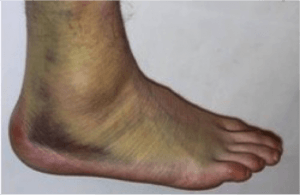When people present to health professionals (physiotherapists particularly) with sports related injuries or pain, a common question asked is should I ice the injury or use heat? This is particularly relevant in the athletic and sporting community as it is quite common to do a muscle strain or ligament sprain (eg. rolled ankle).

If you or a friend suffer a soft tissue injury the best advice we can give you is seek prompt medical advice. The research is very conclusive – early accurate assessment and prompt appropriate treatment is much better than delay. Additionally, what may appear to be a simple muscle, ligament or soft tissue injury can include a hairline fracture, bony bruising or dislocation.
For decades, we have used ice in the management of acute injuries despite the serious lack of reasoning behind it. Is it a waste of time or counterproductive to overall healing? I was taught at university that ice is preferred for the initial 2-3 days post-injury. Generally it is prescribed to apply ice for 20 minutes, every 2 – 3 hours for the first few days until the “heat” and swelling comes out of the injury. Ice has an effect on the chemoreceptors in the tissue as well which helps reduce your pain and decreases inflammatory cell activity in traumatic soft tissue injuries. Although we know it has an effect on pain perception, it is still unclear whether or not we should be icing injuries at all and research is still being conducted on this.
There is a serious lack of evidence supporting the use of ice as a treatment modality, and yet it is still one of the most accessible treatments available to the public. The main reason ice is prescribed after a soft tissue injury is to give pain relief and decreased inflammation/swelling. The question raised is why do we want to avoid the normal post injury swelling that occurs for normal hearing? Inflammation is an inevitable and an essential biological response following acute soft tissue injuries. It is a protective attempt by the body to remove the damaging stimuli and to begin the healing process.
Acute inflammation results in vasodilation and increased permeability at the arteriole and capillary levels, which are brought on by the actions of various inflammatory mediators. This allows more blood to arrive, and with it leukocytes and macrophages (white blood cells) to “clean up” the injured site.

The build up of fluid, swelling or edema at the site should be considered a positive reaction as it increases sensitivity to pain (to prevent us from further injuring the tissue), restricts movement (to prevent us from further injuring the tissue) and allows the inflammatory process to progress (to help us repair the injured tissue).
Recent evidence is showing that if we interfere with the natural healing process too much by excessive icing or resting, the long-term negative effects on the injuries prognosis increase greatly. Our bodies lymphatic system is our own way of clearing swelling and studies have shown that icing can cause a reversal effect on this system, leading to prolonged swelling. Now obviously not all research is conclusive, and this topic is still being highly debated among medical professionals and researchers but it is always important to ask why do we do what we do? And for some reason we like to put ice on ourselves to make the pain go away, without really questioning why.
Now, moving onto heat (including heat rubs like deep heat). Heat is best avoided in the first 48 hours after injury. During an acute injury there is bleeding within the tissue, which heat can increase. This encouraged bleeding can be detrimental if used to early. Once the “heat” has come out of your injury, heat packs can be used to stimulate blood flow which brings with it lots of oxygen, waste removal and healing cells. It is recommended to use heat for 20 minutes a few times a day for this reason, which will speed up your healing rate. Heat also helps muscles relax and eases pain. Heat wheat packs are an excellent home solution for a multitude of conditions. Heat may also be used in chronic pain and degenerative conditions such as arthritis and chronic tendinopathies for these properties. Whereas, ice will not have as good if an effect on people with these types of conditions.
So if you are unsure on the extent of your injury or which one you should be using, consult with your physiotherapist or health professional.


